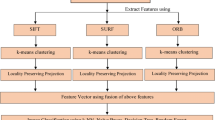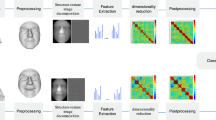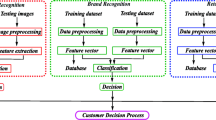Abstract
This paper presents a content-based image retrieval technique that focuses on extraction and reduction in multiple features. To obtain multi-level decomposition of the image by extracting approximation and correct coefficients, discrete wavelet transformation is applied to the RGB channels initially. Therefore, both approximation and correct coefficients are applied to the dominant rotated local binary pattern termed as texture descriptor which is computationally effective and rotationally invariant. For a local neighbor patch, a rotation invariance function image is obtained by measuring the descriptor relative to the reference. The proposed approach contains the complete structural information extracted from the local binary patterns and also extracts the additional information using the information of magnitude, thereby achieving extra discriminative power. Then, GLCM description is used by obtaining the dominant rotated local binary pattern image to extract the statistical characteristics for texture image classification. The proposed technique is applied to CORAL dataset with the help of particle swarm optimization-based feature selector to minimize the number of features that can be used during the classification process. The three classifiers, i.e., support vector machine, K-nearest neighbor, and decision tree, are trained and tested. The comparison is based in terms of Accuracy, precision, recall, and F-measure performance metrics for classification. Experimental results show that the proposed approach achieves better accuracy, precision, recall, and F-measure values for most of the CORAL dataset classes.














Similar content being viewed by others
References
Vr P et al (2019) An enhanced coding algorithm for efficient video coding. J Inst Electron Comput 1(1):28–38
Kumar MR (2019) A compact graphene based nano-antenna for communication in nano-network. J Inst Electron Comput 1(1):17–27
Petkovic D (2019) Adaptive neuro fuzzy determination of impactful factors on non-uniformity of polished surface. J Inst Electron Comput 1(1):9–16
Dehghani M, Montazeri Z, Malik O, Al-Haddad K, Guerrero JM, Dhiman G (2020) A new methodology called dice game optimizer for capacitor placement in distribution systems. Electr Eng Electromech 1:61–64
Chandrawat RK, Kumar R, Garg B, Dhiman G, Kumar S (2017) An analysis of modeling and optimization production cost through fuzzy linear programming problem with symmetric and right angle triangular fuzzy number. In: Proceedings of sixth international conference on soft computing for problem solving. Springer, pp. 197–211
Kaur A, Jain S, Goel S (2019) Sandpiper optimization algorithm: a novel approach for solving real-life engineering problems. Appl Intell 50:1–38
Singh P, Dhiman G (2017) A fuzzy-LP approach in time series forecasting. In: International conference on pattern recognition and machine intelligence. Springer, pp 243–253
Saravanan M, Priya A (2019) An algorithm for security enhancement in image transmission using steganography. J Inst Electron Comput 1(1):1–8
Dhiman G, Kaur A (2017) Spotted hyena optimizer for solving engineering design problems. In: 2017 international conference on machine learning and data science (MLDS). IEEE, pp 114–119
Bistouni F, Jahanshahi M (2020) Evaluation of reliability in component-based system using architecture topology. J Inst Electron Comput 2:57–71
Verma S, Kaur S, Dhiman G, Kaur A (2018) Design of a novel energy efficient routing framework for wireless nanosensor networks. In: 2018 First international conference on secure cyber computing and communication (ICSCCC). IEEE, pp. 532–536
Kaur A, Dhiman G (2019) A review on search-based tools and techniques to identify bad code smells in object-oriented systems. In: Harmony search and nature inspired optimization algorithms. Springer, pp 909–921
Dhiman G, Kaur A (2019) A hybrid algorithm based on particle swarm and spotted hyena optimizer for global optimization. In: Soft computing for problem solving. Springer, pp 599–615
Dhiman G, Kumar V (2019) Spotted hyena optimizer for solving complex and non-linear constrained engineering problems. In: Harmony search and nature inspired optimization algorithms. Springer, pp 857–867
Schettini R, Ciocca G, Gagliardi I (2009) Feature extraction for content-based image retrieval. In: Encyclopedia of database systems, pp 1115–1119
Yue J, Li Z, Liu L, Fu Z (2011) Content-based image retrieval using color and texture fused features. Math Comput Model 54(3–4):1121–1127
Wang Y, Gong M, Wang T, Cohen-Or D, Zhang H, Chen B (2013) Projective analysis for 3d shape segmentation. ACM Trans Graph (TOG) 32(6):192
Mandal S, Viswanath P, Yeshaswini N, Dean-Ben XL, Razansky D (2015) Multiscale edge detection and parametric shape modeling for boundary delineation in optoacoustic images. In: 2015 37th Annual international conference of the IEEE engineering in medicine and biology society (EMBC). IEEE, pp 707–710
Zhang D, Lu G (2001) Content-based shape retrieval using different shape descriptors: a comparative study. In: IEEE international conference on multimedia and expo. IEEE, p 289
Anh ND, Nam BN, Hoang NH et al (2010) A new cbir system using sift combined with neural network and graph-based segmentation. In: Asian conference on intelligent information and database systems. Springer, pp 294–301
Dhiman G, Kumar V (2017) Spotted hyena optimizer: a novel bio-inspired based metaheuristic technique for engineering applications. Adv Eng Softw 114:48–70
Singh P, Dhiman G (2018) A hybrid fuzzy time series forecasting model based on granular computing and bio-inspired optimization approaches. J Comput Sci 27:370–385
Dhiman G, Kumar V (2018) Multi-objective spotted hyena optimizer: a multi-objective optimization algorithm for engineering problems. Knowl Based Syst 150:175–197
Kaur A (2019) A systematic literature review on empirical analysis of the relationship between code smells and software quality attributes. Arch Comput Methods Eng, pp 1–30
Singh P, Dhiman G (2018) Uncertainty representation using fuzzy-entropy approach: special application in remotely sensed high-resolution satellite images (rshrsis). Appl Soft Comput 72:121–139
Dhiman G, Kumar V (2018) Emperor penguin optimizer: a bio-inspired algorithm for engineering problems. Knowl Based Syst 159:20–50
Dhiman G, Kaur A (2018) Optimizing the design of airfoil and optical buffer problems using spotted hyena optimizer. Designs 2(3):28
Singh P, Rabadiya K, Dhiman G (2018) A four-way decision-making system for the Indian summer monsoon rainfall. Mod Phys Lett B 32(25):1850304
Dhiman G, Kumar V (2018) Astrophysics inspired multi-objective approach for automatic clustering and feature selection in real-life environment. Mod Phys Lett B 32(31):1850385
Ozdemir A, Polat K (2020) Deep learning applications for hyperspectral imaging: a systematic review. J Inst Electron Comput 2(1):39–56
Petković D, Denić N (2020) Neuro-fuzzy assessment of pupil performance based on e-learning platform implementation. J Inst Electron Comput 2(1):12–27
Saravanan M (2020) An l-shaped slot circularly polarized patch antenna for wireless communication. J Inst Electron Comput 2(1):1–11
Kaur A, Kaur S, Dhiman G (2018) A quantum method for dynamic nonlinear programming technique using Schrödinger equation and Monte Carlo approach. Mod Phys Lett B 32(30):1850385
Singh P, Dhiman G, Kaur A (2018) A quantum approach for time series data based on graph and Schrödinger equations methods. Mod Phys Lett A 33(35), 1850208
Celik C, Bilge HS (2017) Content based image retrieval with sparse representations and local feature descriptors: a comparative study. Pattern Recognit 68:1–13
Huang W, Gao Y, Chan KL (2010) A review of region-based image retrieval. J Signal Process Syst 59(2):143–161
Lowe DG (2004) Distinctive image features from scale-invariant keypoints. Int J Comput Vis 60(2):91–110
Bay H, Ess A, Tuytelaars T, Van Gool L (2008) Speeded-up robust features (surf). Comput Vis Image Underst 110(3):346–359
Dalal N, Triggs B (2005) Histograms of oriented gradients for human detection
Ojala T, Pietikainen M, Harwood D (1994) Performance evaluation of texture measures with classification based on Kullback discrimination of distributions. In: Proceedings of 12th international conference on pattern recognition, vol 1. IEEE, pp 582–585
Tan X, Triggs W (2010) Enhanced local texture feature sets for face recognition under difficult lighting conditions. IEEE Trans Image Process 19(6):1635–1650
Chang H, Yeung D-Y (2006) Locally linear metric adaptation with application to semi-supervised clustering and image retrieval. Pattern Recognit 39(7):1253–1264
Zhang D, Islam MM, Lu G (2012) A review on automatic image annotation techniques. Pattern Recognit 45(1):346–362
Gao Y, Chan KL, Yau W-Y (2007) Learning in content based image retrieval-a brief review. In: 2007 6th international conference on information, communications and signal processing. IEEE, pp 1–5
Liao S, Law MW, Chung AC (2009) Dominant local binary patterns for texture classification. IEEE Trans Image Process 18(5):1107–1118
Guo Z, Zhang L, Zhang D (2010) Rotation invariant texture classification using lbp variance (lbpv) with global matching. Pattern Recognit 43(3):706–719
Guo Z, Zhang L, Zhang D (2010) A completed modeling of local binary pattern operator for texture classification. IEEE Trans Image Process 19(6):1657–1663
Su S-Z, Chen S-Y, Li S-Z, Li S-A, Duh D-J (2010) Structured local binary haar pattern for pixel-based graphics retrieval. Electron Lett 46(14):996–998
Ahonen T, Pietikäinen M (2007) Soft histograms for local binary patterns. In: Proceedings of the Finnish signal processing symposium, FINSIG, vol 5(9), p 1
Iakovidis DK, Keramidas EG, Maroulis D (2008) Fuzzy local binary patterns for ultrasound texture characterization. In: International conference image analysis and recognition. Springer, pp 750–759
Chandrasekhar V, Takacs G, Chen D, Tsai S, Grzeszczuk R, Girod B (2009) Chog: Compressed histogram of gradients a low bit-rate feature descriptor. In: 2009 IEEE Conference on computer vision and pattern recognition. IEEE, pp 2504–2511
Chandrasekhar V, Reznik Y, Takacs G, Chen D, Tsai S, Grzeszczuk R, Girod B (2010) Quantization schemes for low bitrate compressed histogram of gradients descriptors. In: 2010 IEEE computer society conference on computer vision and pattern recognition-workshops. IEEE, pp 33–40
Wang X, Han TX, Yan S (2009) An hog-lbp human detector with partial occlusion handling. In: 2009 IEEE 12th international conference on computer vision. IEEE, pp 32–39
Zhang B, Gao Y, Zhao S, Liu J (2009) Local derivative pattern versus local binary pattern: face recognition with high-order local pattern descriptor. IEEE Trans Image Process 19(2):533–544
Guo Z, Li Q, You J, Zhang D, Liu W (2012) Local directional derivative pattern for rotation invariant texture classification. Neural Comput Appl 21(8):1893–1904
Oberoi A, Bakshi V, Sharma R, Singh M (2013) A framework for medical image retrieval using local tetra patterns. Int J Eng Technol 5(1):27–36
Fan K-C, Hung T-Y (2014) A novel local pattern descriptor-local vector pattern in high-order derivative space for face recognition. IEEE Trans Image Process 23(7):2877–2891
Srivastava P, Khare A (2017) Integration of wavelet transform, local binary patterns and moments for content-based image retrieval. J Vis Commun Image Represent 42:78–103
Mehta R, Egiazarian K (2016) Dominant rotated local binary patterns (drlbp) for texture classification. Pattern Recognit Lett 71:16–22
Liu L, Zhao L, Long Y, Kuang G, Fieguth P (2012) Extended local binary patterns for texture classification. Image Vis Comput 30(2):86–99
Verma M, Raman B (2015) Center symmetric local binary co-occurrence pattern for texture, face and bio-medical image retrieval. J Vis Commun Image Represent 32:224–236
Dhiman G, Guo S, Kaur S (2018) Ed-sho: a framework for solving nonlinear economic load power dispatch problem using spotted hyena optimizer. Mod Phys Lett A 33(40):1850239
Dhiman G, Kumar V (2019) Seagull optimization algorithm: theory and its applications for large-scale industrial engineering problems. Knowl Based Syst 165:169–196
Dhiman G, Kaur A (2019) Stoa: a bio-inspired based optimization algorithm for industrial engineering problems. Eng Appl Artif Intell 82:148–174
Dhiman G, Kumar V (2019) Knrvea: a hybrid evolutionary algorithm based on knee points and reference vector adaptation strategies for many-objective optimization. Appl Intell 49(7):2434–2460
Dhiman G, Singh P, Kaur H, Maini R (2019) Dhiman: a novel algorithm for economic d ispatch problem based on optimization met h od us i ng m onte carlo simulation and a strophysics co n cepts. Mod Phys Lett A 34(04):1950032
Dhiman G (2019) Moshepo: a hybrid multi-objective approach to solve economic load dispatch and micro grid problems. Appl Intell 50:1–19
Singh P, Dhiman G, Guo S, Maini R, Kaur H, Kaur A, Kaur H, Singh J, Singh N (2019) A hybrid fuzzy quantum time series and linear programming model: special application on taiex index dataset. Mod Phys Lett A 34(25):1950201
Dhiman G (2019) Esa: a hybrid bio-inspired metaheuristic optimization approach for engineering problems. Eng Comput, pp 1–31
Dhiman G (2019) Multi-objective metaheuristic approaches for data clustering in engineering application(s). Ph.D. dissertation
Dehghani M, Montazeri Z, Malik OP, Dhiman G, Kumar V (2019) Bosa: binary orientation search algorithm. Int J Innov Technol Expl Eng 9:5306–5310
Eberhart RC, Shi Y, Kennedy J (2001) Swarm intelligence. Elsevier, Amsterdam
Junior FEF, Yen GG (2019) Particle swarm optimization of deep neural networks architectures for image classification. Swarm Evol Comput 49:62–74
Maini R, Dhiman G (2018) Impacts of artificial intelligence on real-life problems. Int J Adv Res Innov Ideas Educ 4:291–295
Pallavi, Dhiman G (2018) Impact of foreign direct investment on the profitability: a study of scheduled commercial banks in India. Comput Appl Math J 4:27–30
Garg M, Dhiman G (2020) Deep convolution neural network approach for defect inspection of textured surfaces. J Inst Electron Comput 2:28–38
Kaur S, Awasthi LK, Sangal A, Dhiman G (2020) Tunicate swarm algorithm: a new bio-inspired based metaheuristic paradigm for global optimization. Eng Appl Artif Intell 90:103541
Dhiman G, Soni M, Pandey HM, Slowik A, Kaur H (2020) A novel hybrid hypervolume indicator and reference vector adaptation strategies based evolutionary algorithm for many-objective optimization. Eng Comput, pp 1–19
Kaur A, Jain S, Goel S (2017) A support vector machine based approach for code smell detection. In: 2017 International conference on machine learning and data science (MLDS). IEEE, pp 9–14
Alfaro C, Cano-Montero J, Gómez J, Moguerza JM, Ortega F (2016) A multi-stage method for content classification and opinion mining on weblog comments. Ann Oper Res 236(1):197–213
Quinlan J (1986) Induction of decision trees. Mach Learn 1:81–106
Kaur A, Jain S, Goel S. Sp-j48: a novel optimization and machine-learning-based approach for solving complex problems: special application in software engineering for detecting code smells. Neural Comput Appl, pp 1–19
Kaur H, Peel A, Acosta K, Gebril S, Ortega JL, Sengupta-Gopalan C (2019) Comparison of alfalfa plants overexpressing glutamine synthetase with those overexpressing sucrose phosphate synthase demonstrates a signaling mechanism integrating carbon and nitrogen metabolism between the leaves and nodules. Plant Direct 3(1):e00115
Acknowledgements
Both the authors Dr. Meenakshi Garg and Dr. Gaurav Dhiman would like to thank to their parents for their support and divine blessings on them.
Author information
Authors and Affiliations
Corresponding author
Ethics declarations
Conflict of interest
The authors declare that they have no conflict of interest.
Additional information
Publisher's Note
Springer Nature remains neutral with regard to jurisdictional claims in published maps and institutional affiliations.
Rights and permissions
About this article
Cite this article
Garg, M., Dhiman, G. A novel content-based image retrieval approach for classification using GLCM features and texture fused LBP variants. Neural Comput & Applic 33, 1311–1328 (2021). https://doi.org/10.1007/s00521-020-05017-z
Received:
Accepted:
Published:
Issue Date:
DOI: https://doi.org/10.1007/s00521-020-05017-z




